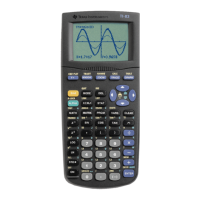Statistics 9-15
These calculations return statistical results based on the list(s) you reference. If
you reference a third list name as an argument for 2-VAR STATS or any of the
regression models, the list is interpreted as the frequencies of occurrence for
the data pairs in the first two lists.
1-VAR STATS
(one-variable statistics,
STAT CALC
, item 1)
analyzes data with one measured variable and calculates
statistical results as indicated on page 9
-
17.
If you reference two list names, the second list is interpreted
as the frequency of occurrence for each data point in the first
list.
1-VAR STATS
listname
1-VAR STATS
Xlistname
,
freqlistname
2-VAR STATS
(two-variable statistics,
STAT CALC
, item 2)
analyzes paired data between which there is a relationship.
This option calculates statistical results as indicated on page
9-17.
The first list you reference is the independent variable (X list).
The second list is the dependent variable (Y list). If you
reference a third list name, it is interpreted as the frequency of
occurrence for each data pair in the first two lists.
2-VAR STATS
Xlistname
,
Ylistname
2-VAR STATS
Xlistname
,
Ylistname
,
freqlistname
LINREG (aX+b)
(linear regression,
STAT CALC
, item 3) fits
the data to the model y=ax+b using a least-squares fit and
x
and
y
. It displays
a
(slope),
b
(y-intercept), and
r
(correlation
coefficient).
LINREG (aX+b)
Xlistname
,
Ylistname
LINREG (aX+b)
Xlistname
,
Ylistname
,
freqlistname
Types of Statistical Analysis
1-VAR STATS
2-VAR STATS
LINREG
(aX+b)

